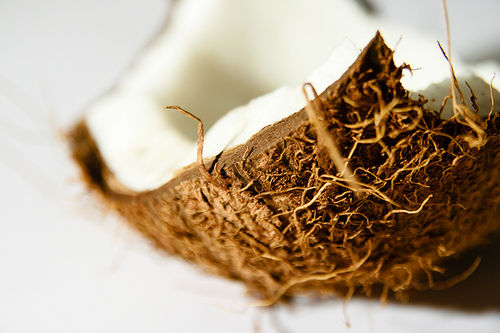Of course, when Kelly hipped me to coir, a natural fiber made from coconut, I couldn’t pass it up! Coir fiber is extremely durable and water-resistant. It’s commonly used in things like rope and rugs. To extract the fiber, workers grind up the coconut husk. There are two types of coir: white and brown. White fiber is made by “retting,” a process where the immature husks are soaked in water for 8-10 months The micro-organisms in the water naturally loosen the fiber from the rest of the coconut hull. Once it’s loosened, it’s beaten by hand of in a defibering machine to extract the long fibers which are spun into a durable yarn on a spinning wheel (like the woman in the photo to the right). White fiber is commonly used in things like ropes and door mats. You would see brown fiber used in items like hair brushes. It is also made by soaking the coconut, but only for a few days before the fibers are beaten or they head to the defibering machine. They separate the bristly, elastic fibers through wet milling. According to Commodity Online: I think its applications as a soil conditioner and a natural ground cover to help stop erosion are particularly fab! You can find coir fiber for the garden at online shops like Planet Natural. My only concern about coir fiber is how and where farmers are growing the coconut palms. Farming palms for oil has resulted in mass deforestation in places like Malaysia. Are folks clearing out rain forest to grow these palms for their fibers, or are they harvesting trees that were naturally growing? That would make all the difference. So what do you think? Is coir fiber as sustainably delicious as it sounds? Image Credits: Coconut. Creative Commons photo by bzyla Spinning Coir Rope. Creative Commons photo by urbangarden

